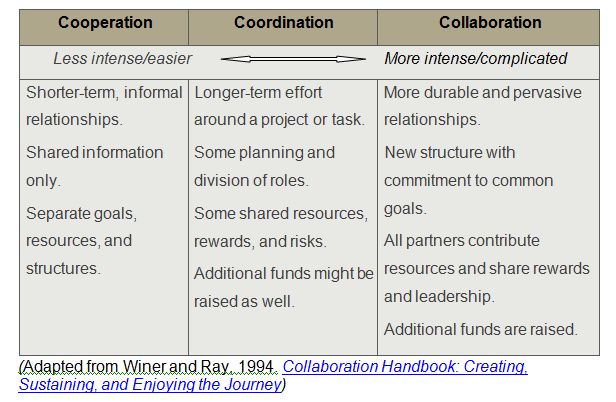- Start early. Building your alliance early helps to ensure shared ownership and to make full use of complementary skills and experience.
- Start with a small core alliance and grow it gradually. Particularly if your organization has limited experience and time, this is advisable rather than going to the complex stages of group development with dozens of organizations.
- Determine what you need the alliance for. Is it mainly for information (networking), or do you need to coordinate with others, e.g. plan activities together for maximum impact? Are you looking for close cooperation whereby allies pool part of their resources and divide up your work based on a shared campaign platform? It is important that all parties involved agree on the degree of commitment required so that expectations of the different partners are aligned.

- Identify key stakeholders. Determine which organizations can contribute most effectively to the campaign, for example by using stakeholder mapping tools (See Stakeholder Analysis and Key tools to identify targets in this section above).
Key questions include:
- Which organizations are currently working on the campaign issue, or have knowledge and skills relevant to the issue? Women’s groups might be an obvious source for knowledge on VAW, but not necessarily the only one.
- Which technical skills (e.g. media work, social research techniques) are missing in your organization or fledgling alliance, and which organizations can contribute these skills?
- Which organizations are key stakeholders in the issue? E.g. if you advocate to end sexual violence in schools, you may find allies among teachers’ unions or youth organizations.
- Which organizations represent or are close to your target audience? For example, a behaviour change campaign targeting young men may gain from associating organizations that work with boys and young men, e.g. religious youth groups (e.g. YMCA), sports clubs, and boy scout associations.
- Which organizations can mobilize large numbers of diverse supporters or reach many regions, thus extending the scope of the campaign? It can be useful to seek allies that are not commonly part of initiatives to end VAW, e.g. trade unions, professional associations, business corporations and faith-based communities. If it is difficult to gain support from such “mainstream” organizations, women’s networks may offer an entry point – e.g., associations of female media workers, businesswomen’s groups, or women’s trade unions.
- Costs vs. benefits – Balance the number of and expected benefits from potential campaign partners against the effort, time and money related to managing a large alliance. It takes time and resources for all alliance members to learn to work together in a gender-sensitive manner. Any organization invited to join a campaign will balance expected benefits against the resources it will need to invest. If the campaign appears unattractive and potentially ineffective, it may be difficult to find useful partners.
Example: Engaging Religious Leaders in the Middle East and North Africa (MENA)
ABAAD Resource Center for Gender Equality is an organization aimed at promoting sustainable social and economic development in the MENA region through equality, protection and empowerment of marginalized groups, especially women. In 2012, the organization convened a regional roundtable with religious leaders to end gender-based violence. The roundtable brought together muslim and christian leaders to discuss violence against women and how faith-based organizations could better collaborate with civil society organizations. to address this issue. Following the roundtable, the religious leaders issued a global message and released a public service announcement in support of the 16 Days of Activism to End Gender Violence.
- Establish a common understanding of the campaign purpose and strategy. Each organization that joins the campaign alliance must be informed of the campaign goal and strategy, and agree with it. If the alliance is built early in the preparation process, the steps of campaign planning can be completed together. For example, research on the campaign issue may yield richer and deeper insights if it is shaped by the perspectives of different groups rather than a single one.
- Agree on roles and responsibilities. Written agreements or protocols all alliance members sign on to are a central reference point. Such agreements should state the purpose and functioning of the alliance, i.e. reiterate the campaign goal, summarize the strategy, and describe the campaign management structure and the roles of the alliance members. Describe what types of activities linked to the campaign each organization will do – and which they will not do. Agreements may need to be revised over time.
- Develop an appropriate alliance structure: There is no standard approach to structuring an alliance –the form needs to be adapted to the context, the campaign strategy and the alliance members. Some campaigns have a lead alliance member who is fully in charge of central campaign management, with other members focusing on campaign activities within their geographic or thematic realm. A campaign can also be directed by a steering committee that brings together representatives of different alliance members who share equal responsibility in leading the overall campaign. In campaigns managed by a single lead alliance member, it is advisable to create a board or executive committee that represents the wider alliance and oversees campaign management. Written rules should state how the board is elected, how long it serves and how the alliance as a whole can participate in its work (e.g. through annual plenary meetings).
For further guidance, see The Art of Collaborating in Alliances and Managing Conflicts and Unforeseen Crises in the Campaign Implementation section of this module.
Successful alliance campaigns can expand as they attract growing public support. Growth may happen gradually, or in larger, planned steps as part of a scaling-up strategy that brings the campaign to a new dimension. For more information see Growing a Campaign under Campaign Implementation in this module.